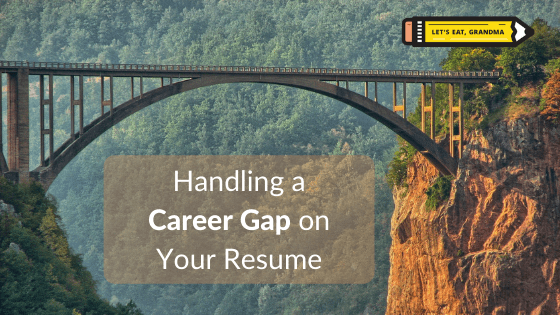Mind the Gap! The “3 D’s” of Handling a Gap in Employment on Your Resume

Worried about a gap in employment on your resume? Don’t be! Career gaps are common and can be easily, honestly handled by using the three D’s.
By: Daniel Lorenzo | Marketing Manager for Let’s Eat, Grandma
So you’ve brushed up your resume with great accomplishments, phrasing, and design, but there’s one thing that’s still stumping you. Every time you look at the document, your eyes can’t escape that…
…giant, gaping hole! (At least that’s what it looks like to you.)
What you’re dealing with is called a gap in employment on your resume. You might have some dates between one job and the next that are missing from your resume because:
Want more job search tips? Sign up for our newsletter!
- You didn’t make the smoothest transition from Job A to Job B.
- You took some time off from working a full-time job to take care of a child or loved one.
- You’ve been unemployed for a long time now.
- You took a gap year to go travel the world.
- You faced any number of other life circumstances.
The gap in employment on your resume does not make you unhireable. Sure, it’s true that a mysterious gap in employment can be a red flag for recruiters, but the sheer fact of having one doesn’t mean that you’ll be automatically rejected.
Honesty is the best policy, career gaps are more common than you think, and recruiters are humans too. A well-explained gap doesn’t have to stand between you and a job.
Let’s walk through how to manage that gap by using a combination of these three D’s: Define, Downplay, and Describe.
#1: Define
Before you try to figure out how to close that gap in employment on your resume, you first need to determine how much of a problem it actually is. It’s likely not as big of a deal as you think.
The thing that turns a career gap into a red flag is if it provokes uncertainty, which we can minimize. The issue isn’t that you weren’t working a full-time job every year of your career. It’s that if the gap is unexplained, they may not know what it says about you.
For all they know, you could have been fired or abruptly quit, your skills could have deteriorated — heck, you may have been hiding from the government after leaking classified information! You don’t want them to jump to conclusions that would call into question your fitness to work there.
So, if you have any of the following supplemental experiences to list on your resume during the dates in which you didn’t have a job, you don’t really have a “gap”:
- Volunteer Experience
- Education
- Professional development courses (Including licenses, certificates, other ways you were upskilling)
- Project Work (independently or for a company)
These are all easy ways to show that you were doing something productive during the dates of the gap on your resume. (We’ll get to how to list them in the next section.)
Plus, how big of a gap are we talking about here? Two to three years, or two to three months? Relatively speaking, the latter gap is about the size of the space between your nephew’s two front teeth, and it’s much easier to close.
And while there’s no magic number that determines when a gap becomes an issue, don’t panic over a gap of just a few months since your last job, especially if you were laid off due to the COVID-19 recession. Good hiring professionals understand that it takes a while to find a job, and with a few Downplay and Describe techniques, you’ll be fine.
Once your gap is defined, there are a few techniques you may be able to use to emphasize your skills and qualifications instead of the gap. Small gaps will generally lean more towards “Downplay”, and larger gaps towards “Describe.” Use any of the following according to your situation:
#2: Downplay
—Remove months from the dates on your resume
This is a common practice among resume writers and career coaches. You should always list the honest dates of your employment, but you can choose to simply list the years of each job without the months, like this:
There’s no rule against this! You should still be prepared to explain what you were doing in between those two jobs, but by removing the months, you reduce the chance that someone will see it as an issue on their initial scan. Plus, if your gap was within the same calendar year, this alone will cover it!
The one exception: if your only perceived gap is less than a few months and crosses over calendar years (say, between November 2019 and January 2020), you may want to leave those months on, as removing them could actually give the impression that there’s a larger gap than there really is. As always, it’s up to your discernment of your own situation.
Remember also to be consistent: if you remove months from one job on your resume, you should remove months for all of them. It will look fishy otherwise.
—Rearrange your resume
Your resume is a fluid document. If you’re filling in your gap with one of the supplemental experiences listed above, you can and should rearrange the sections on your resume to clearly show that the dates are filled.
This could mean moving your Education or Certifications sections up to the top of your resume before your professional experience. If you’re using a volunteer experience to cover the gap, you could potentially move that experience from its own Volunteer Work section into your Professional Experience section. (You may also be able to do this with a coding bootcamp or other project-heavy work.)

We don’t recommend using the popular functional resume format as a way of disguising your gap in employment — but you can rearrange sections.
How about using a different resume format to downplay the gap? We’d advise you to steer clear of the functional resume format, but you can write a hybrid resume that includes a hefty summary and your skills section before your professional experience. This can ensure that your best qualifications are seen before your work history without throwing off the reader. If you’ve had past experience in multiple industries, a “two-tier” resume may also work for you, though it’s not always advised.
—Push an older gap to your second page
(This strategy is best used in conjunction with the strategies above.)
Concerned about a larger gap between jobs from early in your career? First, don’t worry. Gaps in employment are typically less concerning the farther back you go — and you might even be able to cut off your resume at that point and skirt the issue altogether. You don’t need to include every job you’ve ever had.
Second, if you have enough experience to use a two-page resume, consider finding a way to push those jobs to the second page. It’s likely that your reader will spend less time on that page. And if you’ve loaded the first page with your most relevant content like you should, they’ll already be impressed by the time they get there.
#3: Describe
Finally, the best practice with a gap in employment is to be ready to explain it in the context of your career. You’ve done all you can to minimize it on your resume at this point, but you can’t actually rewrite the past. This is especially true if you have a large gap that can’t be completely covered by the strategies above — which, I’ll remind you, is totally okay because recruiters are humans!
Honestly and clearly explain your gap in a manner that shows why it built you up instead of bringing you down, regardless of how well you’ve managed it otherwise. This will not only help you get past the initial resume scan but also ensure that your gap doesn’t disqualify you in further reviews or the interview process.
—Use your cover letter to clarify
No, cover letters are not dead, and their power in defusing gaps in employment is just one reason why.
Your resume needs to be short, skimmable, and value-packed. Since it has to focus on your relevant strengths, it doesn’t have room for a full, contextual explanation of that time between jobs. Including one can actually work against you as it takes attention away from your accomplishments.
Your cover letter on the other hand, with its glorious full paragraphs in your own voice, is the perfect place for an explanation. It can show why you decided to take a sabbatical, why being a stay-at-home parent allowed you to only pursue certifications instead of a full-time job, or why you couldn’t pursue anything while taking care of your ailing relative — and why all of the above actually benefited your career instead of hindering it.

Use your cover letter to briefly explain the story of your gap in employment, focusing on the positives.
Don’t make the mistake of dwelling on the gap in your letter, though. Write an explanation that’s concise, clear, and forward-looking, focusing on the positives and what you learned. It shouldn’t take up more than a few lines.
However, if the Define and Downplay strategies didn’t fully cover the dates of the gap on your resume, you’ll need to put something in there in addition to your cover letter. They may pass on your resume before they even get to the cover letter! The following can be listed and formatted like professional experiences on your resume:
—Explaining Sabbaticals, travel, and “gap years”
Hey, people take time off. We’re more than our work. If you took a long-term break for traveling or a personal research experience, list it. If nothing else, it makes it clear from a scan that you weren’t in jail for that year.
List the experience under a title like “Sabbatical” or “Extended Travel” and briefly describe it, knowing that your cover letter will explain further. Do whatever you can to make the experience impressive and relevant using the tips in this article.
—Explaining personal reasons
Was your gap in employment due to any of the following?
- Caretaking for an ill or elderly family member
- Stay-at-home parenting
- Maternity/Paternity Leave
- Homeschooling
If so, it’s pretty understandable if you didn’t have time for any volunteering, professional development, or other gap-covering activities.
What you can do, however, is list this period as a position on your resume with the title “Caregiver,” “Homeschool Teacher,” etc. Format it like you would a job and include bullet points that describe what you learned and any pro bono professional work you did for friends or family members during that time, as fellow resume writer Virginia Franco recommends.
As you can see, that gap in employment on your resume doesn’t have to spell doom for you. Leverage the power of your resume and cover letter with the tips above, trust in your qualifications, and you’ll be just fine.
Want more job search tips sent straight to your inbox? Sign up for our newsletter here:
Better Resume.
Satisfying Career.
Happier You.


